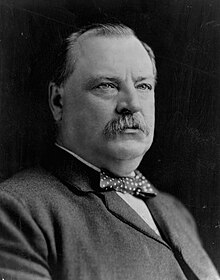
Back Grover Cleveland Afrikaans ግሮቨር ክሊቭላንድ Amharic Grover Cleveland AMI Grover Cleveland AN Grover Cleveland ANG جروفر كليفلاند Arabic ڭروڤر كليڤلاند ARY جروفر كليفلاند ARZ Grover Cleveland AST Grover Cleveland Aymara
Grover Cleveland | |
|---|---|
 Cleveland in 1892 | |
| 22nd & 24th President of the United States | |
| In office March 4, 1893 – March 4, 1897 | |
| Vice President | Adlai Stevenson I |
| Preceded by | Benjamin Harrison |
| Succeeded by | William McKinley |
| In office March 4, 1885 – March 4, 1889 | |
| Vice President |
|
| Preceded by | Chester A. Arthur |
| Succeeded by | Benjamin Harrison |
| 28th Governor of New York | |
| In office January 1, 1883 – January 6, 1885 | |
| Lieutenant | David B. Hill |
| Preceded by | Alonzo B. Cornell |
| Succeeded by | David B. Hill |
| 35th Mayor of Buffalo | |
| In office January 2, 1882 – November 20, 1882 | |
| Preceded by | Alexander Brush |
| Succeeded by | Marcus M. Drake |
| 17th Sheriff of Erie County | |
| In office January 1, 1871 – December 31, 1873 | |
| Preceded by | Charles Darcy |
| Succeeded by | John B. Weber |
| Personal details | |
| Born | Stephen Grover Cleveland March 18, 1837 Caldwell, New Jersey, U.S. |
| Died | June 24, 1908 (aged 71) Princeton, New Jersey, U.S. |
| Resting place | Princeton Cemetery |
| Political party | Democratic |
| Spouse | |
| Children | 6, including Ruth, Esther, Richard, and Francis |
| Parent |
|
| Relatives |
|
| Occupation |
|
| Signature | |
| ||
|---|---|---|
|
Personal
28th Governor of New York
22nd & 24th President of the United States
First presidency
First post-presidency
Second presidency
Presidential campaigns
Second post-presidency
 |
||
Stephen Grover Cleveland (March 18, 1837 – June 24, 1908) was the 22nd and 24th president of the United States, serving from 1885 to 1889 and from 1893 to 1897. He was the first Democrat to win the presidency after the Civil War and was one of only two presidents to be elected to serve non-consecutive terms.[b]
Cleveland was elected mayor of Buffalo in 1881 and governor of New York in 1882. While governor, he closely cooperated with state assembly minority leader Theodore Roosevelt to pass reform measures, winning national attention.[1] He led the Bourbon Democrats, a pro-business movement opposed to high tariffs, free silver, inflation, imperialism, and subsidies to businesses, farmers, or veterans. His crusade for political reform and fiscal conservatism made him an icon for American conservatives of the time.[2] Cleveland also won praise for honesty, self-reliance, integrity, and commitment to the principles of classical liberalism.[3] His fight against political corruption, patronage, and bossism convinced many like-minded Republicans, called "Mugwumps", to cross party lines and support him in the 1884 presidential election, which he narrowly won against Republican James G. Blaine. In the 1888 election, he ran against Benjamin Harrison, winning the popular vote but losing the electoral college and therefore the election. After his loss, he returned to New York City and joined a law firm. In the 1892 election, Cleveland defeated Harrison in both the popular vote and electoral college, restoring him to the White House. As his second administration began, the Panic of 1893 sparked a severe national depression. Many voters blamed the Democrats, opening the way for a Republican landslide in 1894 and for the agrarian and Silverite seizure of the Democratic Party in 1896. An anti-imperialist,[4] Cleveland opposed the push to annex Hawaii, launched an investigation into the 1893 coup against Queen Liliʻuokalani, and called for her to be restored.[5][6]
Cleveland was a formidable policymaker but also garnered criticism. He intervened in the 1894 Pullman Strike to keep the railroads moving, angering Illinois Democrats and labor unions nationwide; his support of the gold standard and opposition to free silver alienated the agrarian wing of the Democrats.[7] Critics complained that Cleveland had little imagination and seemed overwhelmed by the nation's economic disasters—depressions and strikes—in his second term.[7] By the end of his second term, he was severely unpopular, even among Democrats.[8]
After leaving the White House, Cleveland served as a trustee of Princeton University and continued to voice his political views. He died in 1908. Cleveland has been praised more recently for honesty, integrity, adherence to his morals, defying party boundaries, and effective leadership and is typically ranked in the middle to upper tier of U.S. presidents.
Cite error: There are <ref group=lower-alpha> tags or {{efn}} templates on this page, but the references will not show without a {{reflist|group=lower-alpha}} template or {{notelist}} template (see the help page).
- ^ "Grover Cleveland Birthplace". National Park Service. Archived from the original on April 4, 2024. Retrieved May 18, 2023.
- ^ Blum, 527
- ^ Jeffers, 8–12; Nevins, 4–5; Beito and Beito
- ^ "The Spanish-American War: The United States Becomes a World Power". Library of Congress. Archived from the original on December 11, 2023. Retrieved May 16, 2023.
In June 1898, the American Anti-Imperialist League was formed ... Its members included former President Grover Cleveland.
- ^ Williams, Ronald Jr. (2021). "Special Rights of Citizenship and the Perpetuation of Oligarchic Rule in the Republic of Hawai'i, 1894–1898". Hawaiian Journal of History. 55 (1): 71–110. doi:10.1353/hjh.2021.0002. ISSN 2169-7639. S2CID 244917322.
- ^ "Grover Cleveland on the Overthrow of Hawaii's Royal Government". Digital History. University of Houston. 1893. Archived from the original on December 15, 2023. Retrieved May 16, 2023.
- ^ a b Tugwell, 220–249
- ^ President-Making in the Gilded Age: The Nominating Conventions of 1876–1900 by Stan M. Haynes page 2
